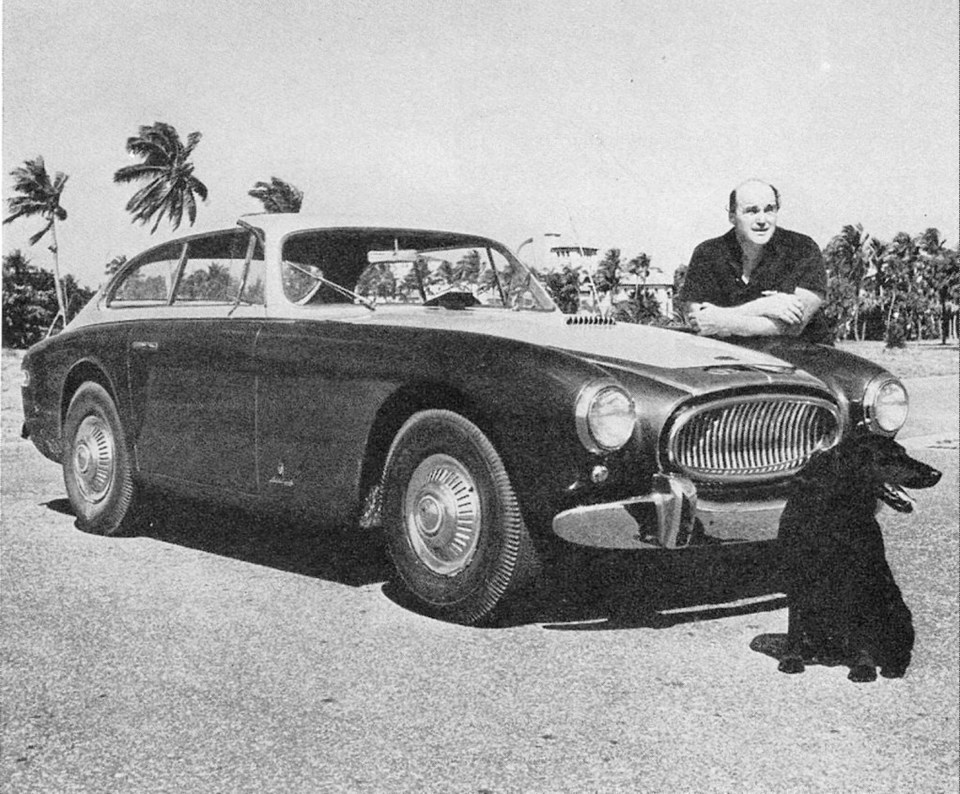Tom McCahill was America’s pioneering car tester whose writing appeared in Mechanix Illustrated magazine from 1946 to the mid-’70s. His inimitable style and humorous prose regaled eager readers on the handling, performance and styling of everything from hot rods to Packards. Readers may note that I occasionally use him as a reference.
Thomas Jay McCahill III was born into a wealthy family in Larchmont, New York, in 1907. He proudly claimed a direct bloodline to Scottish highwayman Rob Roy MacGregor.
Tom’s father and grandfather were lawyers who amassed fortunes in law and real estate. But Tom graduated from Yale University with a BA in fine arts.
He played sports and as a youth sustained a football injury that left his left leg 89 millimetres shorter. Never properly treated, it gave him a serious limp, although photos concealed this.
Tom’s artistic desire led him to Manhattan’s Art Students’ League, but it came to nought. He lived a playboy’s life, sailing out of Larchmont and fooling around with cars, until the Depression severely depleted his inheritance.
Tom’s father was New York branch manager for Mercedes for a while, so he became acquainted with many interesting cars. In the early 1930s, Tom opened the Murray Hill Garage in Manhattan to service prestige cars such as Rolls-Royces and Duesenbergs, but the Depression killed the business.
He tried writing and sold some stories on such subjects as marine engines to publications such as Yachting, Popular Science and Reader’s Digest. In 1945, Tom convinced Mechanix Illustrated to try his car tests. His first report, of his own 1946 Ford, appeared in February 1946.
Although popular with readers it took Tom a while to convince auto manufacturers to co-operate. “We test our own cars, thank you,” they sniffed.
But by posing as a photographer with loads of equipment, Tom spirited away enough cars for testing to build a reputation that could not be ignored. He also got cars from dealers and friends such as bandleader and hunting buddy Paul Whiteman and millionaire car builder/ racer Briggs Cunningham.
Although lacking much technical training, Tom’s general car knowledge gave his reports an authoritative ring. Even more important was gutsy humorous prose salted with similes and peppered with hyperbole.
Among Tom’s memorable turns of phrase was calling the MG TC “as intriguing as a night on the Orient Express.” The 1952 De Soto was “rugged, tough, reliable as the Rock of Gibraltar — and just about as fast.” The 1951 Oldsmobile would “wind up like a Chinese fiddle” and the 1958 Rambler American was “as sexy as galoshes.” A lugging four-cylinder engine suffered “torque agony.”
Among his more memorable exploits was the Tucker test. On a dare from derisive Ford officials during lunch at Michigan’s Dearborn Inn (“There were loud guffaws and table thumping at the mention of the Tucker operation,” said Tom), he called Preston Tucker in Chicago to ask when he could test the revolutionary Tucker.
“Any time you want,” said Tucker. While Tom was surprised, the Ford men were aghast; nobody in the industry believed Tucker was building a genuine, driveable car. Tom’s August 1948 Tucker test, the first by a journalist, was one of his most famous. Tom delighted in telling readers that Ford even picked up the tab for the phone call.
In 1948, Tom bought an 80-acre farm near Glen Gardner, New Jersey. He gradually began spending more time in Florida, and in 1959 moved to Ormond Beach, a historical hotbed of speed.
Tom’s golden writing years were the 1950s and ’60s, and his methods would be considered pretty rough and ready today. He scoffed at the fifth wheel and would have had apoplexy over computerized equipment. Tom used a handheld stopwatch, the car’s speedometer and measured miles he marked off with paint spots on roads around the country.
I visited Tom in 1974 in his Ormond Beach home. He looked smaller than his six-foot-one, 240-pound frame, and not quite the swashbuckling, bald (he called himself Old Chrome Dome), moustachioed character we knew through the pages of MI. He was in a wheelchair and missing a leg.
We reminisced a while, and he remembered every test with complete clarity. Regarding the leg, he said he got a thorn in it while hunting and it turned gangrenous.
Surgery was necessary. “Just before they put me under,” Tom told me, “I said, ‘Doc, if you can’t fix it, just take it off.’ I thought I was kidding … but damned if he didn’t.” He said it with a perfectly straight face, and I’m still not sure whether he was putting me on.
Tom McCahill died in Daytona Community Hospital on May 10, 1975, marking the end of an entertaining and flamboyant chapter in automotive journalism.
